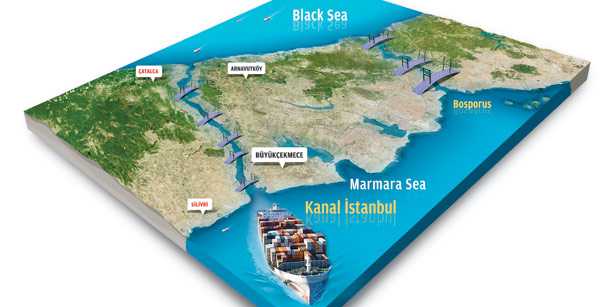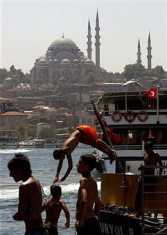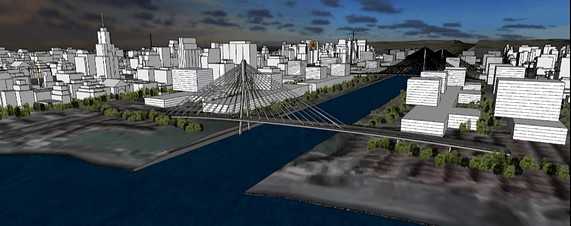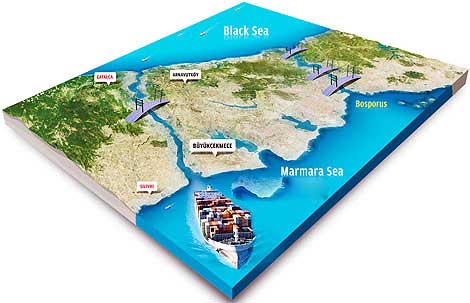 The İstanbul Strait will become the world’s most important center of hydrogen energy if the construction of a second canal that has been publicized by Prime Minister Recep Tayyip Erdoğan as a “crazy project” actually happens. |
|
| If the tankers use the canal for transportation, the traffic in the Bosporus will be minimized, and the sea flow in the strait will be used for the generation of hydrogen energy. Before the announcement of the Kanal İstanbul project, the International Center for Hydrogen Energy Technologies (ICHET) founded by the United Nations Industrial Development Organization (UNIDO) in Turkey in 2003 was planning to generate electrical energy out of the flow in the Bosporus.
However, the project was never implemented because of the heavy traffic in the Bosporus and a lack of infrastructure. In case the project is actually implemented, UNIDO-ICHET will station a turbine on a submarine in Arnavutköy-İstanbul to start generation of electricity. The center authorities who concluded that the magnitude of the undersea flow is sufficient for generation of electricity will produce 20 kilowatts of electricity by a generator to be installed on a platform in the strait. The turbine that will generate electricity will produce energy out of the flow eight meters below the surface. Subsequent to the move of the traffic load to Kanal İstanbul, the project will be fully implemented for effective use of the flow. During the initial stages, electrical energy will be generated out of the undersea flow from the Black Sea to the Marmara Sea along the Bosporus Strait. By using this energy, the seawater purified of ions will be electrolyzed to produce hydrogen. The generated hydrogen will be stored under heavy pressure. The high-pressure hydrogen will be used as fuel in an internal combustion engine to produce mechanical energy that will be transformed into electrical energy for future use. On the other hand, the high-pressure hydrogen will also be filled in tanks for end-use. Use of this sort of energy will help combat environmental degradation because it does not produce exhaust gas. The biggest handicap with hydrogen energy despite it being renewable, sustainable and highly efficient as well as environment-friendly is lack of the necessary technological infrastructure, and its excessive cost. Current projections note that Europe will completely abandon oil and natural gas as energy sources and embrace hydrogen energy in 2030, whereas this will be the case in the entire world by 2070. Turkey believes that it seized a chance to become a world center of hydrogen energy after the making of a deal envisaging establishment of an international center for hydrogen energy technologies in Turkey in Vienna in 2003. The UN picked Turkey over China, Japan, Canada and Norway as the host country of the center in 2004; the center has done remarkable work to fulfill its mandate over the past years. The center, which was assigned the task to ensure information flow between developing and developed countries in respect to the development of hydrogen technologies, install pilot facilities operable by hydrogen energy, identify hydrogen energy policies and produce fuel batteries and deal with environmental affairs, storage techniques, transport systems and applications for vehicles, has successfully completed some pilot projects so far. The center, set to implement a hydrogen-run three-wheel vehicle project in India, a hydrogen island project, hydrogen-run marine vehicle project in Turkey and production of hydrogen out of solar energy project in Libya, seems to have made visible progress in respect to hydrogen technology and storage. One of the biggest projects of the center was launched on Feb 16. ICHET decided to launch the first hydrogen filling facility in Eyüp-Feshane. A hydrogen filling station that generates hydrogen by use of electrolysis, a first in Turkey, will be constructed by Hydrogenics, a leading company in the sector specialized in generation of hydrogen and fuel cells. Turkey’s first hydrogen filling station will meet the fuel needs of the land and sea vehicles. The station, the only station in the world that will offer hydrogen filling services for both land and sea vehicles, will also address the needs of special vehicles operated by hydrogen technology. The hydrogen filling operation will be performed under 350 bar pressure. After the launch of the station, Turkey will become one of the countries with a hydrogen station in Europe after Norway, Iceland and Germany. ICHET also placed orders for bus and automobiles for use in the hydrogen station that will be in service by the end of 2011. The first tender will be held in the days to come. On the other hand, the first hydrogen-run boat in Turkey is being constructed in the Tuzla shipyards. The project, ordered by Istanbul Seabus Enterprise (IDO), is being implemented jointly with Istanbul University. The project attracts attention of Japanese and Korean firmsTurkey’s works on hydrogen energy has attracted a great deal of attention from countries in the Far East. Japanese automobile firm Mazda has decided to introduce its RX-8 Hydrogen RE cars, offered for sale in Europe last month, to the Turkish market. Hyundai also reportedly is getting ready to offer its Tucson cars for sale in Turkey. Reports also indicate that the authorities are holding meetings and negotiations with some firms in Hungary for purchase of hydrogen-operated buses that will be mainly used at the airports. The center’s ambitious projects include meeting the energy needs of an entire island using hydrogen technology, as 1,000 houses in Bozcaada will be heated and illuminated by hydrogen energy, while 60 vehicles on the island will also use hydrogen for fuel. A similar project will be implemented on Sedef Island as well. Another project will ensure that the entire energy needs of a hospital in Ankara are met by hydrogen energy. Within the project, hydrogen energy will be used for all battery-operated wheelchairs. Moreover, hydrogen technology will be used as source of fuel for information-based sectors because of its ability to provide uninterrupted energy. Boron for storage safetyUNIDO-ICHET also launched joint projects with the Turkish Boron Institute to minimize the danger associated with the storage of hydrogen energy. To this end, boron will be used as a hydrogen carrier. When used in the vehicles, hydrogen remains under 350 bar pressure. This poses a great danger for vehicles; for this reason, this project was drafted for implementation jointly with the Boron Institute. The boron is able to store hydrogen in the form of sodium borohydride (NaBH4). This way, it becomes possible to use hydrogen by reliance on a simple chemical process. |
Tag: Canal Istanbul
-

İstanbul to become world center for hydrogen energy
-

Erdogan’s crazy plan unveiled | beyondbrics
By David O’Byrne of business new europe
 With his party expected to win its third overall majority in general elections on June 12, Tayyip Erdogan, Turky’s prime minister, seems set on establishing his own legacy with his long-promised “crazy project” finally unveiled this week: a 50-kilometre long, 120-metre wide canal that his government plans to construct 100 km west of Istanbul between the Black Sea and the Sea of Marmara.
With his party expected to win its third overall majority in general elections on June 12, Tayyip Erdogan, Turky’s prime minister, seems set on establishing his own legacy with his long-promised “crazy project” finally unveiled this week: a 50-kilometre long, 120-metre wide canal that his government plans to construct 100 km west of Istanbul between the Black Sea and the Sea of Marmara.Wide and deep enough for supertankers of up to 300,000 deadweight tonnage – bigger than the biggest tankers in use today – the canal will have no locks and will use passing places and a mooring basin midway to allow simultaneous traffic in both directions – in contrast to the dangerously overcrowded Bosphorus strait, which must be closed in both directions to allow the largest tankers through.
The aim is simple. With oil production in the Caspian region expected to double to around 40m tonnes over the next decade, the number of tankers using the Bosphorus is also expected to double from a current average of 27 a day – a volume of traffic that threatens to overload the strait and expose Istanbul to an environmental disaster in the event of an accident.
The new canal would reduce traffic through the Bosphorus and – with none of the twists and turns of its natural neighbour – offer a safer and quicker route.
That aim in itself is not new. Turkey has for years been backing a project to bypass the Bosphorus: the Samsun Ceyhan pipeline, sponsored by a consortium of Turkey’s Calik Energy and Eni, which would link the Black Sea with the Mediterranean.
People close to the project told bne that the Samsum-Ceyhan pipeline remains firmly on the agenda, as the Turkish government expects Caspian oil production to grow enough to justify both the pipeline and the canal. But with Turkey obliged by the 1936 Montreux convention to allow free passage through the Bosphorus, Samsun-Ceyhan has so far failed to secure commitments of sufficient oil to ensure its viability.
“The same problem applies to a canal as to a pipeline – if one is free and one has a tariff, then there has to be a group agreement between oil shippers as to how much oil they send through each,” says John Roberts, Caspian specialist at Platts, an energy consultancy. “The only alternative is to renegotiate the Montreux treaty, which Russia for one would not be open to.”
The people close to the project told bne that Ankara does indeed hope to renegotiate Montreux, despite the expected difficulties. But with Russia having apparently gone back on its promise to provide oil for Samsun-Ceyhan, many are viewing the canal as a bargaining ploy to pressure Moscow to moderate its demands for a majority stake in the pipeline – albeit one that doubles as a handy pre-election stunt.
Nevertheless, many find the boldness of the project compelling, although many too question the rather low $10bn cost estimate.
“As a logistics engineer, I think it’s a great idea,” says Ergin Buyukbayram, a logistics consultant who last year produced a major report on logistics in Turkey. “But it will be very difficult to build and will cost a lot more than they predict – maybe $20bn-25bn at least.”
With shippers unlikely to pay to use the canal while transit through the Bosphorus is free, Ankara plans to offset at least part of the cost by selling real estate along the canal banks. Erdogan has argued that continued migration to Istanbul calls for bold plans to expand the city.
Many remain unimpressed with that idea, pointing to the tens of thousands of unsold properties on out-of-town estates built in the bubble of property speculation that pre-dated the global economic crisis.
“Demand for out-of-town property is low because most jobs are inside the city, and transport links are abysmal,” says one Istanbul property developer, who reckons it would take a major sea change to persuade employers to move 100 km into Thrace.
And the historic precedent for such massive infrastructure projects is not encouraging.
The Panama Canal was only built at the second attempt after a massive financial scandal; the Manchester Ship Canal Company went bankrupt twice before a rescue by Manchester city council allowed ships to sail direct to the landlocked industrial city; early income from the Suez Canal was so low that it required the development of a new way of calculating tonnage to rack up transit fees.
All of which suggests that if Erdogan really does get his place in history, it may be the Turkish taxpayer who will foot the bill.
via Erdogan’s crazy plan unveiled | beyondbrics | News and views on emerging markets from the Financial Times – FT.com.
-

Another ‘Crazy Project’ for Istanbul
By Ayla Albayrak

European Pressphoto Agency A graphic of a canal project, planned to be built through Istanbul. A graphic of a canal project, planned to be built through Istanbul.
First, Turkey’s Prime Minister Recep Tayyip Erdogan announced what he called a “crazy” project to build a shipping canal parallel to the Bosporus strait. On Wednesday he outlined another one: to build two new earthquake resistant urban centers on the outskirts of Europe’s biggest metropolis, Istanbul.
Mr. Erdogan’s idea is to build one of the cities along the Black Sea coast, on the European side of the Bosporus. The other would go on the Asian side.
There’s a big element of electioneering here. Mr. Erdogan made both announcements as his governing Justice and Development, or AK Party prepares for elections to a third term in office on June 12, a vote that opinion polls suggest the AK Party will win.
But few would write off Mr. Erdogan’s grand plans entirely, in an economy that grew 8.9% last year and an earthquake prone city whose population, by official estimates, is at least 13.5 million and growing fast.
The promise is to build new, “more humane” housing and move residents to a safer area, away from “ugly buildings in neighborhoods with unsafe, narrow streets” in parts of Istanbul, Mr. Erdogan said at an election event in Istanbul. “If you think that (in an earthquake), damage of 100 billion could occur, we do not think this project would be too heavy a load for our country,” Mr. Erdogan said.
In 1999, over 17 000 people were killed in an earthquake here. The epicenter was more than 100 kilometers from Istanbul, yet many of the casualties occurred in the city. Seismologists are forecasting another big one in the relatively near future.
Completing the vast project would be a long-debated third bridge across the Bosporus, close to the Black Sea coast. The highways that feed that bridge would also connect the two new urban centers, Mr. Erdogan said. Istanbul would get a new airport with a capacity of 60 million passengers a year — roughly the size of London’s Heathrow.
Feasibility studies will start right after the elections, and construction a year after, according to the prime minister. But he is looking for votes from architects or city planners, Mr. Erdogan is likely to be disappointed.
“Istanbul has the capacity to grow up to 17 million, but this project could inflate it into a city of 25-30 million people. It paves way to serious and irreversible problems” such as suburban ghettos, said Eyup Muhcu, Istanbul head of the Chamber of Architects of Turkey.
Mr. Muhcu also said that Mr. Erdogan is ignoring the city’s current plan, which bans construction in the forests and farmland along the Black Sea Coast. Much of the city’s drinking water comes from the area.
via Another ‘Crazy Project’ for Istanbul – Emerging Europe Real Time – WSJ.
-

Canal Istanbul
Istanbul Canal (Turkish: Kanal İstanbul) is the name of the artificial sea-level waterway, which is proposed to be built by the Republic of Turkey on the European side of Turkey, connecting the Black Sea to the Sea of Marmara. Canal Istanbul would disect the current European side of Istanbul into two and thus create an Island between the continents of Asia and Istanbul (The Island would have a shoreline to the Black Sea, Sea of Marmara, Istanbul Canal and the Bosphorus).[1][2][3] The new waterway would bypass the current Bosphorus. Istanbul Canal aims to minimise shipping traffic in the Istanbul Strait. The project is intended for the 100th anniversary in 2023 of the foundation of the Turkish Republic.

Historical projects
The concept of a canal linking the Black Sea with the Sea of Marmara was proposed seven times in the history.[4]
The first proposal was made by Sultan Suleiman the Magnificent (reigned 1520–1568). His architect Mimar Sinan was said to have devised plans for the project. The project was abandoned for unknown reasons.[4]
On March 6, 1591, during the reign of Sultan Murad III, an imperial ferman (order) was issued and work on the project recommenced, but again for unknown reasons the project was stoped.
In 1654 during the reign of Sultan Mehmed IV, pressure for the reccomencement of the canal was applied but to no avail.
Sultan Mustafa III (reigned 1757–1774) tried twice in 1760 but the project could not go ahead due to economic problems.
During the reign of Sultan Mahmud II, an Imperial Ottoman Committee was established to examine the project once again. A report was prepared in 1813 but no concrete steps were taken.
Finally, on January 17, 1994 shortly before the local elections, the leader of the Democratic Left Party (DSP) Bülent Ecevit proposed a canal connecting the Black Sea with the Sea of Marmara.[4][5]
Istanbul Canal
It was not until April 2009, when the Justice and Development Party (AKP) government began secret studies into the project once again and that concrete steps were taken for the revival of the project. The project was mentioned by Minister of Transport Binali Yıldırım in May 2009 at the parliament.[6] Prime minister Recep Tayyip Erdoğan announced the “Istanbul Canal” project on April 27, 2011 during a rally held in connection with the upcoming 2011 general elections, calling it as his “crazy project” (Turkish: çılgın proje).[7]
The main purpose of the project is to reduce the marine traffic through the Bosphorus and minimize the risks and dangers associated particularly with tankers.[7][8] About 56,000 vessels pass yearly through the Istanbul Strait, among them 10,000 tankers carrying 145 million tons of crude oil. International pressure is growing to increase the marine traffic tonnage through the Turkish straits that brings risks for the security of marine navigation during the passage.[6] The canal will further help prevent the pollution caused by cargo vessels passing through or mooring in the Sea of Marmara Sea before the southern entrance of the Bosphorus.[8]
The waterway will have a length of 45–50 km (28–31 mi) with a depth of 25 m (82 ft).[7] Its width will be 150 m (490 ft) on the surface and 120 m (390 ft) at the canal bed. These dimensions will allow the largest vessels to pass.[8]
Studies relating to the project will be accomplished within two years. The canal will be in service latest in 2023, the 100th anniversary of the foundation of the Republic. The project will be financed completely by domestic sources.[8]
Cost
The Turkish Prime Minister Recep Tayyip Erdogan and Istanbul Metropolitan Municipality officials have stated that Istanbul Canal will cost $10 billion to build and that the financing for the development has already been allocated by the Turkish Treasury.[9][10][11] They further added that they would be relying entirely on national resources. It is envisaged that Turkish Armed Forces personnel would play a key role in the Canal’s development.
Criticism
Some critics have stated that Turkey aims to by-pass the Montreux Convention Regarding the Regime of the Turkish Straits and attain greater autonomy with respect to the passage of military ships from the Black Sea to the Sea of Marmara.[12][13]
References
- ^ “Turkey to build new waterway to bypass Bosporus”. Forbes. 2011-04-27. .
- ^ “Turkey plans ‘crazy’ new canal”. UK News. 2011-04-28. .
- ^ “Turkey to build waterway to bypass Bosphorus Straits”. BBC. 2011-04-27. https://www.bbc.co.uk/news/world-europe-13207304.
- ^ a b c “1994’te Ecevit ortaya attı, manşetlere ‘mega proje’ diye yansıdı”. Hürriyet. 2011-04-28. . Retrieved 2011-05-01.
- ^ “”Kanal İstanbul” Ecevit’in projesi çıktı” (in Turkish). CNN Türk. 2011-04-27. https://www.cnnturk.com/yasam/diger/kanal-istanbul-ecevitin-projesi-cikti. Retrieved 2011-05-01.
- ^ a b “”Çılgın proje”yi Binali Yıldırım daha önce açıklamıştı” (in Turkish). CNN Türk. 2011-04-27. https://www.cnnturk.com/yasam/diger/cilgin-projeyi-binali-yildirim-daha-once-aciklamisti. Retrieved 2011-05-01.
- ^ a b c Çıtak, Pınar (2011-04-27). “PM Erdoğan speaks out his ‘crazy project’; İstanbul Canal”. Doğan Haber Ajansı. . Retrieved 2011-00-01.
- ^ a b c d “İstanbul’a ikinci boğaz: “Kanal İstanbul”” (in Turkish). 2011-04-29. https://www.cnnturk.com/turkiye/istanbula-ikinci-bogaz-kanal-istanbul. Retrieved 2011-05-01.
- ^
- ^
- ^
- ^ “İstanbul Canal project to open debate on Montreux Convention”. Today’s Zaman. 2010-10-08. .
- ^ “Turkey debates whether international treaty is obstacle to plan to bypass the Bosporus”. The Washington Post. 2011-04-29. .
-

Turkey signals it may reconsider Bosporus fees
ANKARA, Turkey
Turkey is studying ways to make it more attractive for commercial ships to travel through a proposed canal as an alternative to the heavily congested Bosporus Strait.
Turkey wants to reduce the shipment of oil, liquefied gas and chemicals through the Bosporus and reduce the risk of accidents in the narrow waterway that bisects Istanbul, a city of more than 12 million. Prime Minister Recep Tayyip Erdogan recently announced a new canal project that would create a second waterway linking the Mediterranean Sea with the Black Sea.
The Montreux Convention of 1936, however, requires Turkey to allow commercial ships through the strait, while restricting the passage of military ships.
But Transportation Minister Mehmet Habib Soluk said Turkey could reconsider its policy of charging discounted fees for transit through the Bosporus Strait, a possible hint that those fees might be raised.
Soluk told the Anatolia news agency on Thursday that since the 1980s, transit fees have been disounted but “certainly, new arrangements on the fees may come.”
Increasing the Bosporus fees could encourage ships to use the proposed Canal Istanbul, even though fees are expected to be charged to cover its construction costs.
Turkey said it has no plans to block passage through the Bosporus. But it believes the canal, which would link the Black Sea to the Sea of Marmara further west of Istanbul, would attract ships that the prime minister said lose about $1.4 billion annually by waiting at either end of the Bosporus for permission to cross through.
via Turkey signals it may reconsider Bosporus fees – BusinessWeek.
-

Canal Istanbul detailed
Istanbul Mayor Kadir Topbas said the new shipping canal proposed by Turkey would handle 150-160 ships per day, IHS World Markets Energy reported.
The waterway, proposed as an alternate to the cramped Bosporus, would take eight years to build for an estimated US$10 billion, Topbas added.
The Canal Istanbul scheme to link the Black Sea with the Sea of Marmara was unveiled yesterday by Prime Minister Recep Tayyip Erdogan.
Ships would still need to transit the Dardanelles to reach the Aegean Sea.
As IHS Fairplay reported recently, the canal would run 45-50km in length, with a depth of about 25m and a width of 150m, added Erdogan, who said it would accommodate ships up to 300,000dwt.
It would cut through government-owned land – mostly undeveloped forest – just west of Istanbul, reported the Wall Street Journal, which added that backers claim it would create thousands of jobs for workers at Turkish companies.
“Erdogan’s unveiling of the plan, which has long been dreamed about by Turkish strategic thinkers, came across in large part as an election-season ploy, and the political opposition dismissed it as such, citing the cost and unrealistic nature
of the still-half-baked proposal,” IHS World Markets Energy commented.
The prime minister said today’s long waits to enter the Bosporus, which is just 700m wide at its narrowest point and has strong currents and several blind turns, cost shippers US$1.4 billionn per year.
The scheme might be aimed at gaining leverage for Turkey in talks with Russia to secure commitments of crude for the as-yet-unbuilt Samsun-Ceyhan oil pipeline, one of a range of other Bosporus bypass pipeline proposals, IHS World Markets Energy said.
If Canal Istanbul is built, “the rationale for projects such as Samsun-Ceyhan and the
Burgas-Alexandroupolis pipeline linking Bulgaria to Greece could be undermined”, it pointed out, however adding: “Rising levels of oil exports from Kazakhstan and Russia could still necessitate construction of pipelines to bypass the Bosporus if Turkish officials intend to divert all oil traffic away from [it], as Erdogan insinuated yesterday.”
via Canal Istanbul detailed – Dredging News Online.
